Invasive Species Week 2023
From the 15th to 21st May 2023, over 260 organisations across England, Wales, Scotland, Northern Ireland, Ireland, Jersey, Guernsey, and the Isle of Man took part in Invasive Species Week.
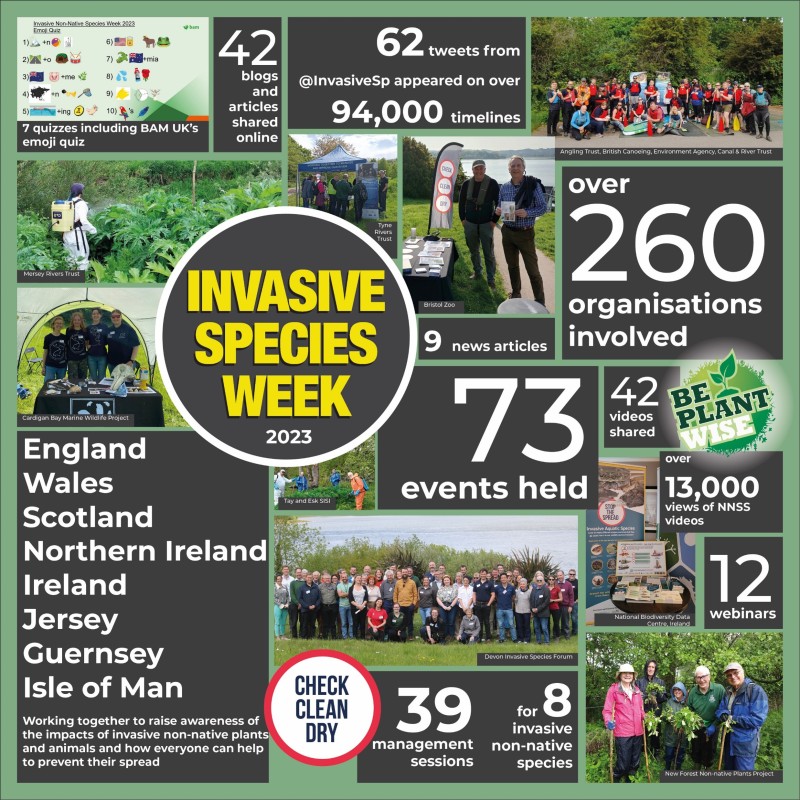
Seventy-three events were held including a fantastic 39 management sessions to tackle 8 species, many with the help of volunteers. Read updates from some of the organisations involved and find out more about volunteering with a Local Action Group.
Twelve webinars were held online on topics ranging from tracking invasive predators and removing floating pennywort, to the impacts of invasive non-native species on the island of Montserrat and the use of biosecurity dogs to help protect endangered seabirds on islands. Watch NNSS webinar recordings.
Some organisations launched new or updated materials during the week, including OATA’s relaunched Biosecurity Risk Assessment Tool & Guide to help aquatic retailers improve their biosecurity, and the Wye Invasive Species Project’s Balsam Action Toolkit to help Local Action Groups tackle Himalayan balsam.
A world premiere took place, with the launch of Alchemilla mollis – the animation, from Teesdale School and 1st Middleton-in Teesdale Scouts.
On Twitter (external link) 42 blogs and articles were shared, along with 42 videos, and 62 tweets from the official GB Invasive Species Week account (external link) reached over 94,000 timelines and received 13,000 video views.
To complete the week the BSBI held an invasive non-native plant themed #WildflowerHour (external link) challenge online on Sunday evening.
Thank you to everyone involved for a fantastic week!
Find out more
Updates from some of the participating organisations
- The Angling Trust and British Canoeing
- New Forest Non-native Plants Project
- Tyne Rivers Trust
- Bristol Zoo
- South West Invasive Species Forum
- Wye Invasive Species Project
Other activities and resources
Updates from some of the participating organisations
The Angling Trust and British Canoeing
Thursday 18th May: Voluntary Floating Pennywort Removal – River Lea Navigation
Anglers & Paddlers united once again to clean up our waterways in removing the Invasive Non-Native plant species, floating pennywort. This species poses a huge risk to our aquatic eco-systems and the consistent hard work from Angling & Paddling clubs has prevented loss of recreational activities ensuring our waterways remain accessible.
The day was a huge success and very enjoyable with nearly 40 volunteers signed up. We worked strategically downstream, covering 1.5 miles of River whilst removing every bit of Floating Pennywort from fragments to huge raft-like mats. It was great to see volunteers from organisations such as, Thames Water, Environment Agency, and The Canal & Rivers Trust. Over 1Tonne of Floating Pennywort was removed from the river, and majority of the material was collected by CABI who transported the FP back to their laboratory to feed their Weevils for their ongoing “Biocontrol” trial.
As always, Biosecurity is paramount any time you are on the water. We always ensure volunteers arrive and leave with clean & dry equipment which will prevent the spread of other Invasive Non-Native Species as well as fish disease and pathogens.
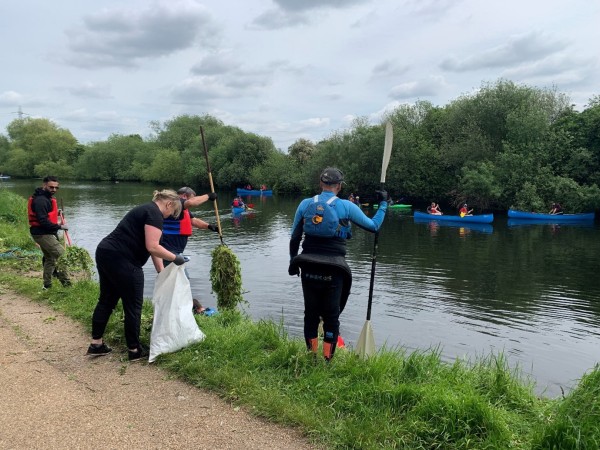
Volunteers helping to remove floating pennywort from the bank while paddlers collect it from the water. Image: Angling Trust
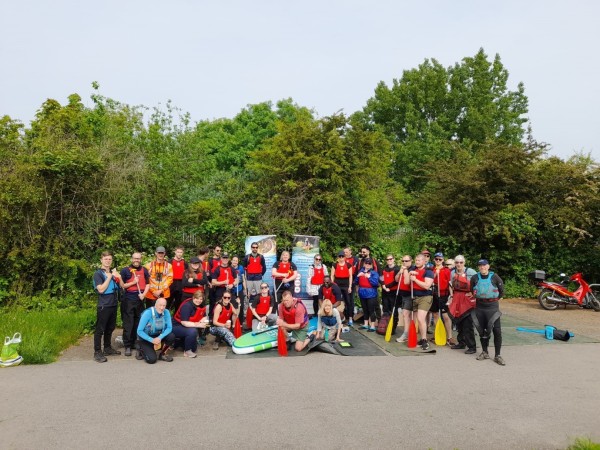
Volunteers at the washdown station used to ensure that no floating pennywort was spread elsewhere after the event. Image: Angling Trust
New Forest Non-native Plants Project
The New Forest Non-native Plants Project had a busy Invasive Species Week:
- Monday: leading a balsam pull, the first volunteer work party of the season.
- Tuesday: visiting 11 garden centres in the New Forest area to share Be Plant Wise materials.
- Wednesday: recording American skunk cabbage along the Fleet Water, monitoring the results of work undertaken in 2022 to control yellow azalea, and recording rhododendron.
- Thursday and Friday: leading balsam pulls along the Cadham River.
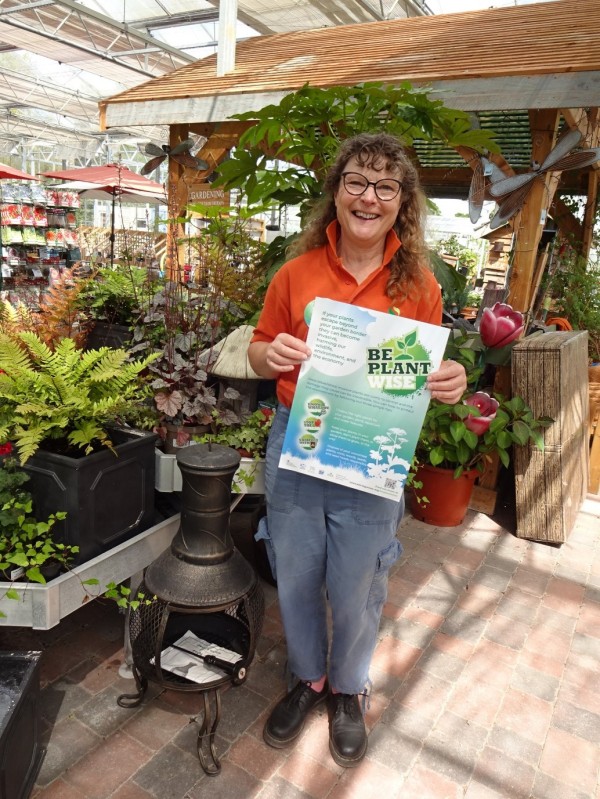
Staff at the garden centres were pleased to take and display Be Plant Wise information. Image: New Forest Non-native Plants Project
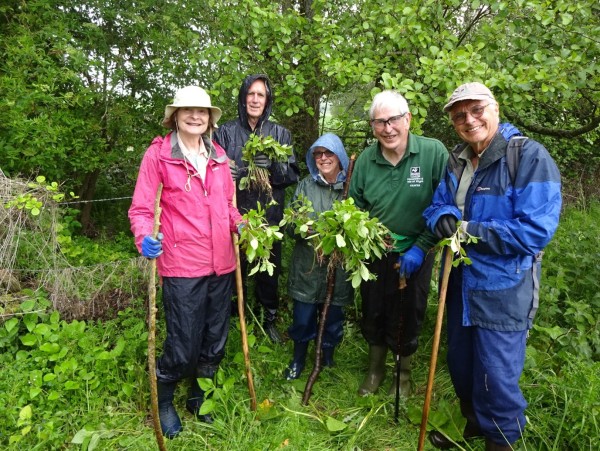
Volunteers helping to pull balsam. Image: New Forest Non-native Plants Project
Tyne Rivers Trust
Tyne Rivers Trust carried out treatment of 150m2 of giant hogweed and 100m2 of Japanese knotweed. They ran a pop-up information stand where they met the local volunteer team and useful contacts from other organisations, making plans to work together in future.
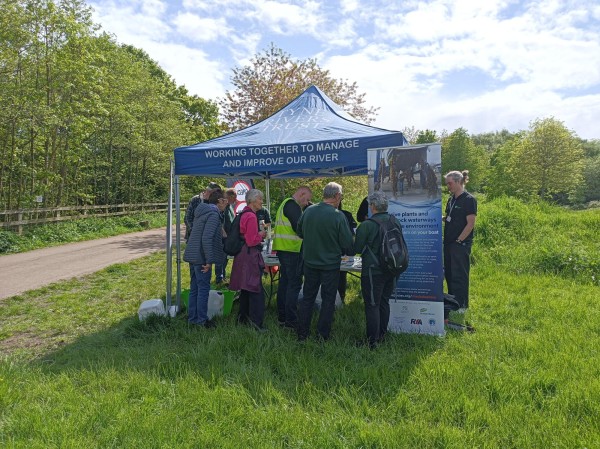
Visitors to the awareness raising stand. Image: Tyne Rivers Trust
Bristol Zoo
On Friday 19th May Bristol Zoo ran an information stand at Chew Valley Lake, a Bristol Water AQUA accredited site. Over four hours they spoke to around 50 anglers about INNS and biosecurity and handed out awareness raising materials. The following day they led a biosecurity demonstration and information session at Channel Kayaks in Bath, where they spoke to around 40 paddlers, gave washdown and Check Clean Dry demonstrations, handed out stickers and phone cases, and presented Channel Kayaks with their Bronze AQUA award.
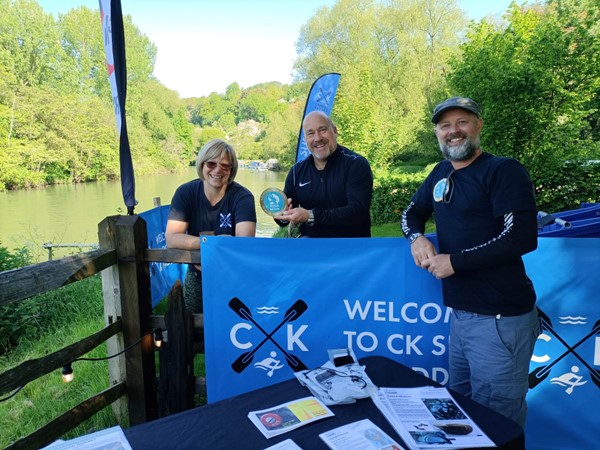
Presenting the AQUA award to Channel Kayaks for their onsite biosecurity measures. Image: Bristol Zoo.
South West Invasive Species Forum
The sixth annual South West Invasive Species Forum hosted by South West Water and South West Lakes Trust took place at Roadford Lake on Tuesday 16th May. Attendees enjoyed talks on mink, grey squirrels, crayfish conservation and more.
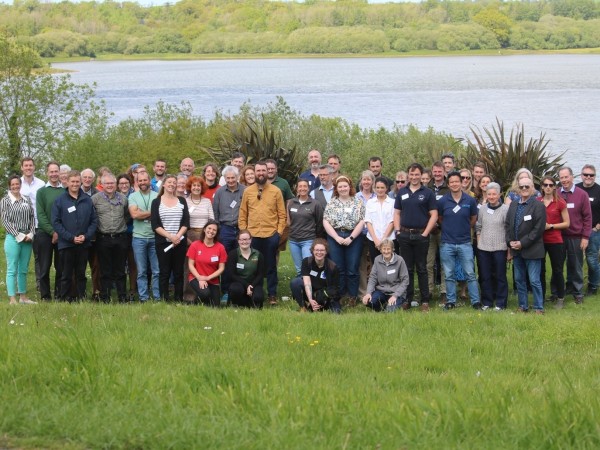
Attendees at the South West Invasive Species Forum: Image South West Water
Wye Invasive Species Project
The Wye Invasive Species Project (external link) re-launched their Balsam Action Toolkit (B.A.T) in English and Welsh, providing all the support that individuals and community groups might need to get this pest plant under control.
The B.A.T is a free resource consisting of info. guides and working documents to help users identify balsam at various growing stages, answer critical questions, help rally support and set up an action group, map and report balsam, and plan and run successful and safe events. Posters, risk assessments, route maps, kit lists, log sheets, consent forms.. it's all in there!
Ultimately the B.A.T is here to free up more of your time so you can get outside and get pulling. And, given the speed of spread of this plant across lowland Britain, we really want to see the B.A.T being utilised far and wide.
Download a digital version (external link) and contact Nickie for hard copy versions.
Events
Monday 15th May
- Webinar: Rabbits; the good, the bad and the ugly. Devon Invasive Species Initiative.
- Webinar: Removing floating pennywort on the Lee Navigation. With British Canoeing.
- Webinar: Tracking invasive predators in Orkney, with the Orkney Native Wildlife Project.
- Management: Giant hogweed spraying, Mersey Rivers Trust
- Awareness raising: pop up information stand at Glenveagh National Park, Ireland
- Management: Natural England volunteers removing pacific oysters from Ramsgate Western Undercliffe
- Management: Volunteer control day at Bertha Park with Perth and Kinross Climate Action
- Management: Rogue River Cleanup to remove invasive weeds
- Management: Himalayan balsam bash, New Forest Non-native Plants Project
Tuesday 16th May
- Event: South West Invasive Species Forum 6. With South West Lakes Trust and South West Water, at Roadford Reservoir, Devon.
- Webinar: Non-native plants in the BSBI Plant Atlas 2020. Hosted by the NNSS.
- Management: Himalayan balsam removal event with Tyne Rivers Trust at Derwenthaugh Park.
- Webinar: Removing floating pennywort on the Lee Navigation. With British Canoeing.
- Management: Giant hogweed spraying with volunteers. With Tees Rivers Trust.
- Management: Bolin river bank management, Cheshire East
- Management: Environment Agency Anglia officers out controlling floating pennywort and removing Himalayan balsam in St Ives
- Monitoring: North Wales Wildlife Trust Shoresearch volunteers carrying out surveys for invasive marine species
- Awareness raising: visiting local garden centres and nurseries to promote Be Plant Wise, New Forest Non-native Plants Project
- Launch: OATA launched their revamped Biosecurity Risk Assessment Tool & Guide
- Management: Parc Calon Lan balsam bash with the Cwn Taf Nature Network
Wednesday 17th May
- Management: Sour fig removal. With the Guernsey Conservation Volunteers, between Fort Doyle and Beaucette Marina, Guernsey.
- Webinar: Shrew and me: the rise of the greater white-toothed shrew. With the Mammal Society.
- Webinar: Invasive non-native species on the island of Montserrat. Hosted by the NNSS.
- Monitoring: Chelmer Canal Trust group site visit
- Management: Mersey Rivers Trust balsam bash
- Management: Himalayan balsam bash at Bothwell Castle
- Monitoring: recording non-native plants, New Forest Non-native Plants Project
- Management: Ogmore Washeries balsam bash with the Cwn Taf Nature Network
Thursday 18th May
- Webinar: The invasive invasion - are our homes being overtaken? With the Property Care Association.
- Webinar: Greater white-toothed shrew. Hosted by the NNSS.
- Management: Floating pennywort removal event with British Canoeing, the Angling Trust, and Environment Agency at the Canal & River Trust in Enfield Lock.
- Management: Rhododendron management day with WaREN, NWREPP and Action Asylum, in Mold, Wales.
- Management: Himalayan balsam removal event. With Tees Rivers Trust, in Darlington.
- Management: Floating pennywort clearance with the Medway Valley Countryside Partnership and volunteers.
- Management: INNS talk and Balsam bash with UWE
- Management: Balsam bash, Medway Valley Countryside Partnership
- Management: Balsam bash, Mersey Rivers Trust
- Event: Rootwave demonstration with Shropshire Wildlife Trust
- Event: Biosecurity for LIFE activity trail on Mousa
- Monitoring: Saving Scotland's Red Squirrels project officer and volunteers monitoring for red squirrels
- Monitoring: Newcastle University students monitoring for marine non-native species on Lindisfarne through the LIFE WADER project
- Training: Natural England staff being trained in marine invasive non-native species identification by BAM UK
- Management: Balsam pull on the Cadham River, New Forest Non-native Plants Project
Friday 19th May
- Webinar: Jinx the biosecurity dog, with RSPB.
- Webinar: Biosecurity for LIFE. Hosted by the NNSS.
- Training: Free grey squirrel impact assessment in-person training. With the UK Squirrel Accord, in The National Forest.
- Awareness raising: INNS and biosecurity stand at Chew Valley Lake, Bristol Zoo
- Awareness raising: National River Watch, Essex Wildlife Trust
- Management: Balsam bash, Shropshire Wildlife Trust and the Angling Trust
- Management: Volunteering workshop, Keep Britain Tidy
- Management: Environment Agency Anglia staff removing monkey flower from the River Burn in North Norfolk and met with the pennywort action group to discuss work on the Chelmer and Black Water navigation
- Management: River Stewardship Co spraying giant hogweed along the River Swale
- Management: Spey Fishery Board managing invasive plants
- Management: Scottish Invasive Species Initiative volunteers setting up mink traps and controlling invasive plants
- Management: Himalayan balsam removal on the River Rom with Thames 21
- Management: Himalayan balsam pulling day on the River Crane with The Conservation Volunteers
- Management: Bedford Park balsam bash with the Cwn Taf Nature Network
- Management: Balsam pull on the Cadham River, New Forest Non-native Plants Project
- Launch: The Wye Invasive Species Project relaunched their Balsam Action Toolkit.
Saturday 20th May
- Management: Sour fig removal. With the Guernsey Conservation Volunteers, at the Burton Battery, Albecq, Guernsey.
- Event: World premiere of Alchemilla mollis - The Animation by Teesdale School and 1st Middleton-in-Teesdale Scouts. With Teesdale Special Flora Trust at Mickleton Village Hall.
- Management: Floating pennywort removal event with British Canoeing, the Angling Trust, Canal & River Trust and Environment Agency at Stanley Ferry, Wakefield.
- Awareness raising: Protect Nature Now Faire. Join WaREN and other conservation projects for a day of activities and talks at the Welsh Wildlife Centre.
- Management: Himalayan balsam clearance with the Medway Valley Countryside Partnership and volunteers.
- Awareness raising: Get INNS Out! Talks, displays, demonstrations and conservation dogs at Carsington Water Reservoir / Visitor Centre, Derbyshire.
- Management: Ver Valley Society raising awareness and managing Himalayan balsam
- Management: Biosecurity demonstration and information session with Channel Kayaks, Bristol Zoo
- Awareness raising: National Biodiversity Data Centre Ireland promoting Check Clean Dry with Irish Sailing
- Management: Tilhill Forestry staff collecting signal crayfish
- Management: Esk & Tay SISI ran three volunteering days in Tayside
Sunday 21st May
- Awareness raising: Protect Nature Now Faire. Join WaREN and other conservation projects for a day of activities and talks at the Welsh Wildlife Centre.
- Awareness raising: Get INNS Out! Talks, displays, demonstrations and conservation dogs at Draycote Water Reservoir / Visitor Centre, Rugby.
- Webinar: Conservation dogs of Hawaii. With Conservation dogs of Hawaii.
- Event: #WildflowerHour challenge focused on invasive non-native plants, with BSBI.
Later events
- 29th May: Big balsam bash on the River Cray in Bexley with Thames 21.
- 1st June: Floating pennywort removal event with British Canoeing, the Angling Trust, and Environment Agency at the Canal & River Trust in Enfield Lock.
- 27th July: Floating pennywort removal event with British Canoeing, the Angling Trust, and Environment Agency at the Canal & River Trust in Enfield Lock.
Activities
All links are external
Blogs and articles
- APHA Science blog: Invasive species: the silent threat to our ecosystems
- Cefas: What can be done to tackle invasive non-native species
- The Green Blue: Invasive Species Week
- South West Lakes Trust: Invasive Species Week 2023
- Countryside Jobs Service: Invasive Species Week, from the NNSS
- Scottish Wildlife Trust: Ensuring a future for our iconic red squirrel
- CABI: Floating pennywort weevil: feasting to control one of the UK's most invasive aquatic plants
- Amgueddfa Cymru, Museum Wales: Alien invaders
- Fishing in Wales: The green menace - invasive plants
- University of Reading: How can gardeners stop the spread of invasive species?
- RSPB: Turning the tide on an invasive species in Orkney
- Canoe Scotland: Stopping the spread of invasive species
- Nature Scot: How should you manage giant rhubarb in your garden?
- Environmental Controls: The weird and (not so) wonderful
- BTO: Tackling invasives, unpicking the definitions
- BSBI: Invasives week, plants of concern
- British Canoeing: Check, Clean Dry - we all have a role to play in tackling floating pennywort
- Nature Scot: How to help tackle invasive non-native species
- South East Rivers Trust: River Loddon storymap
- Wildlife & Countryside Link: The impact of INNS on trees and woodlands
- WaREN: Invasive Species Week
- Waterlife Recovery Trust: Let's work together, be ambitious and say goodbye to American mink
- APEM Ltd: Sam Hayes on the ever changing world of invasive species
- Game and Wildlife Conservation Trust: Invasive Species Week 2023: Control of American Mink
- Royal Forestry Society: Look out for damaging invasive species
- Essex and Suffolk Rivers Trust: Invasive non-native species week
- APEM Ltd: Q&A with Dr Paul Stebbing
- PCA Property Care: INNS in the built environment
- Tweed Forum: Tweed Invasives Project
- Riverlution: A call to action on Invasive Species Week
- Alliance for Scotland's Rainforests: the threat of rhododendron in Scotland's Rainforests
- BASC: Controlling grey squirrel numbers is crucial
- UK Centre for Ecology & Hydrology: Collaboration to enhance information flow on non-native species across the UK Overseas Territories
- The Rivers Trust All-Ireland: The Rivers Trust warns alien invasion is destroying native biodiversity and costing Irish economy over 200m per year
- White Horse Surveyors: Understanding Japanese knotweed
- CABI: 100 years of Azolla biocontrol
- Canal & River Trust: Tackling invasive species
- Museum of Wales: A new home for some Skomer seaweeds
- Saving Scotland's Red Squirrels: 2023 #InvasiveSpeciesWeek wrap up
- Plantlife: Invasive plant species - what are they and why should we be concerned
- Don Catchment Rivers Trust: How to identify giant hogweed
- The Conservation Volunteers: Invasive non-native plant species in the UK - problems and solutions
News
- Gov.UK: Race against time to save endangered species from deadly disease
- Daily Record: Warning issued over dangers of poisonous giant hogweed plants
- BBC: Sheep can kill invasive giant hogweed, study suggests
- BBC: Anglers asked to kill and report aggressive pink salmon
- Bristol Post: Keep an eye out for 'damaging' invasive plant which could ruin your garden and damage your home
- Wakefield Express: Clean up of the Aire and Calder Navigation at Stanley Ferry near Wakefield to get underway tomorrow
- The National: How Scotland is winning the battle against invasive species
- Sussex Express: Tackling invasive species of plants along the River Ouse
- Guardian: The war on Japanese knotweed
Videos
- South Staffs Water: Middleton Lakes PEBBLE project to combat Crassula helmsii
- Cambridge Water: Floating pennywort eradication PEBBLE project
- Yorkshire Water: about invasive non-native species
- Marine Scotland: marine invasive non-native species
- West Cumbria Rivers Trust: what are invasive non-native species
- Scottish Canals: Common invasive non-native species on canals
- Scottish Canals: Stop the spread of invasive species while paddleboarding
- CABI: Floating pennywort biocontrol
- CABI: Crassula mite
- CABI: Azolla weevil
- UK Centre for Ecology and Hydrology - what are invasive non-native species?
- The Green Blue - 3 ways to stop the spread of invasive non-native species
- OATA: Top tips for better biosecurity in your business
- West Cumbria Rivers Trust: how are INNS spread?
- Environment Agency: Invasive non-native species
- Agri-food and Biosciences Institute: The zebra mussel: spread and impacts in Lough Neagh
- UK Centre for Ecology & Hydrology: Beware of aliens
- Cefas: Invasive marine species
- National Biodiversity Data Centre: The threat of invasive species to Ireland
- IUCN: IUCN global standard to classify impacts from invasive species
- Forestry Commission: Spotting grey squirrel damage
- Perth and Kinross Climate Action: Volunteer day at Bertha park
- Fisheries Management Scotland: Preparing for pink salmon in 2023
- Wye Valley AONB: Himalayan balsam pulling
- Jack Perks: Wels catfish fact file
- Invasive Species Northern Ireland: Invasive Species Week - advice for anglers
- RSPB: Tackling rhododendron
- Scottish Invasive Species Initiative: Tackling INNS on the River Urie
- APEM Ltd: eDNA
- National Botanic Gardens of Ireland: Invasive non-native species
- British Canoeing: Check, Clean, Dry
- Essex Wildlife Trust: What are invasive non-native species?
- Essex Wildlife Trust: Why are invasive non-native species a problem?
- Essex Wildlife Trust: How are invasive non-native species spread?
- NNSS: What are invasive non-native species and how do they affect us?
- NNSS: How are invasive non-native species spread?
- NNSS: How do invasive non-native species affect woodlands and the terrestrial environment?
- NNSS: How do invasive non-native species affect the marine environment?
- NNSS: How do invasive non-native species harm the freshwater environment?
- NNSS: How do invasive non-native species affect our homes and the places we live?
- NNSS: What can I do to help?
- NNSS: Join a Local Action Group
Quizzes
- Canal & River Trust invasive species quiz
- BAM UK & Ireland emoji quiz
- River Thames Conservation Trust quiz
- Yorkshire Invasive Species Forum quiz
